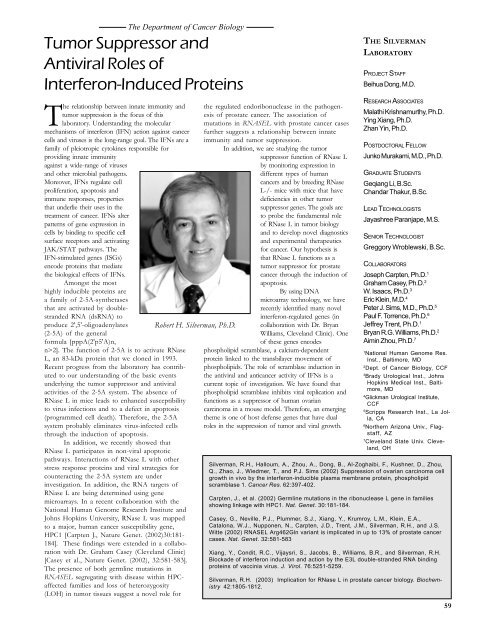Scientific Report 2003-2004 - Cleveland Clinic Lerner Research ...
Scientific Report 2003-2004 - Cleveland Clinic Lerner Research ...
Scientific Report 2003-2004 - Cleveland Clinic Lerner Research ...
- No tags were found...
Create successful ePaper yourself
Turn your PDF publications into a flip-book with our unique Google optimized e-Paper software.
The Department of Cancer BiologyTumor Suppressor andAntiviral Roles ofInterferon-Induced ProteinsThe relationship between innate immunity andtumor suppression is the focus of thislaboratory. Understanding the molecularmechanisms of interferon (IFN) action against cancercells and viruses is the long-range goal. The IFNs are afamily of pleiotropic cytokines responsible forproviding innate immunityagainst a wide-range of virusesand other microbial pathogens.Moreover, IFNs regulate cellproliferation, apoptosis andimmune responses, propertiesthat underlie their uses in thetreatment of cancer. IFNs alterpatterns of gene expression incells by binding to specific cellsurface receptors and activatingJAK/STAT pathways. TheIFN-stimulated genes (ISGs)encode proteins that mediatethe biological effects of IFNs.Amongst the mosthighly inducible proteins area family of 2-5A-synthetasesthat are activated by doublestrandedRNA (dsRNA) toproduce 2',5'-oligoadenylates(2-5A) of the generalformula [pppA(2'p5'A)n,n>2]. The function of 2-5A is to activate RNaseL, an 83-kDa protein that we cloned in 1993.Recent progress from the laboratory has contributedto our understanding of the basic eventsunderlying the tumor suppressor and antiviralactivities of the 2-5A system. The absence ofRNase L in mice leads to enhanced susceptibilityto virus infections and to a defect in apoptosis(programmed cell death). Therefore, the 2-5Asystem probably eliminates virus-infected cellsthrough the induction of apoptosis.In addition, we recently showed thatRNase L participates in non-viral apoptoticpathways. Interactions of RNase L with otherstress response proteins and viral strategies forcounteracting the 2-5A system are underinvestigation. In addition, the RNA targets ofRNase L are being determined using genemicroarrays. In a recent collaboration with theNational Human Genome <strong>Research</strong> Institute andJohns Hopkins University, RNase L was mappedto a major, human cancer susceptibility gene,HPC1 [Carpten J., Nature Genet. (2002)30:181-184]. These findings were extended in a collaborationwith Dr. Graham Casey (<strong>Cleveland</strong> <strong>Clinic</strong>)[Casey et al., Nature Genet. (2002), 32:581-583].The presence of both germline mutations inRNASEL segregating with disease within HPCaffectedfamilies and loss of heterozygosity(LOH) in tumor tissues suggest a novel role forthe regulated endoribonuclease in the pathogenesisof prostate cancer. The association ofmutations in RNASEL with prostate cancer casesfurther suggests a relationship between innateimmunity and tumor suppression.In addition, we are studying the tumorsuppressor function of RNase Lby monitoring expression indifferent types of humancancers and by breeding RNaseL-/- mice with mice that havedeficiencies in other tumorsuppressor genes. The goals areto probe the fundamental roleof RNase L in tumor biologyand to develop novel diagnosticsand experimental therapeuticsfor cancer. Our hypothesis isthat RNase L functions as atumor suppressor for prostatecancer through the induction ofapoptosis.By using DNAmicroarray technology, we haverecently identified many novelinterferon-regulated genes (inRobert H. Silverman, Ph.D. collaboration with Dr. BryanWilliams, <strong>Cleveland</strong> <strong>Clinic</strong>). Oneof these genes encodesphospholipid scramblase, a calcium-dependentprotein linked to the transbilayer movement ofphospholipids. The role of scramblase induction inthe antiviral and anticancer activity of IFNs is acurrent topic of investigation. We have found thatphospholipid scramblase inhibits viral replication andfunctions as a suppressor of human ovariancarcinoma in a mouse model. Therefore, an emergingtheme is one of host defense genes that have dualroles in the suppression of tumor and viral growth.THE SILVERMANLABORATORYPROJECT STAFFBeihua Dong, M.D.RESEARCH ASSOCIATESMalathi Krishnamurthy, Ph.D.Ying Xiang, Ph.D.Zhan Yin, Ph.D.POSTDOCTORAL FELLOWJunko Murakami, M.D., Ph.D.GRADUATE STUDENTSGeqiang Li, B.Sc.Chandar Thakur, B.Sc.LEAD TECHNOLOGISTSJayashree Paranjape, M.S.SENIOR TECHNOLOGISTGreggory Wroblewski, B.Sc.COLLABORATORSJoseph Carpten, Ph.D. 1Graham Casey, Ph.D. 2W. Isaacs, Ph.D. 3Eric Klein, M.D. 4Peter J. Sims, M.D., Ph.D. 5Paul F. Torrence, Ph.D. 6Jeffrey Trent, Ph.D. 1Bryan R.G. Williams, Ph.D. 2Aimin Zhou, Ph.D. 71National Human Genome Res.Inst., Baltimore, MD2Dept. of Cancer Biology, CCF3Brady Urological Inst., JohnsHopkins Medical Inst., Baltimore,MD4Glickman Urological Institute,CCF5Scripps <strong>Research</strong> Inst., La Jolla,CA6Northern Arizona Univ., Flagstaff,AZ7<strong>Cleveland</strong> State Univ. <strong>Cleveland</strong>,OHSilverman, R.H., Halloum, A., Zhou, A., Dong, B., Al-Zoghaibi, F., Kushner, D., Zhou,Q., Zhao, J., Wiedmer, T., and P.J. Sims (2002) Suppression of ovarian carcinoma cellgrowth in vivo by the interferon-inducible plasma membrane protein, phospholipidscramblase 1. Cancer Res. 62:397-402.Carpten, J., et al. (2002) Germline mutations in the ribonuclease L gene in familiesshowing linkage with HPC1. Nat. Genet. 30:181-184.Casey, G., Neville, P.J., Plummer, S.J., Xiang, Y., Krumroy, L.M., Klein, E.A.,Catalona, W.J., Nupponen, N., Carpten, J.D., Trent, J.M., Silverman, R.H., and J.S.Witte (2002) RNASEL Arg462Gln variant is implicated in up to 13% of prostate cancercases. Nat. Genet. 32:581-583Xiang, Y., Condit, R.C., Vijaysri, S., Jacobs, B., Williams, B.R., and Silverman, R.H.Blockade of interferon induction and action by the E3L double-stranded RNA bindingproteins of vaccinia virus. J. Virol. 76:5251-5259.Silverman, R.H. (<strong>2003</strong>) Implication for RNase L in prostate cancer biology. Biochemistry42:1805-1812.59
















